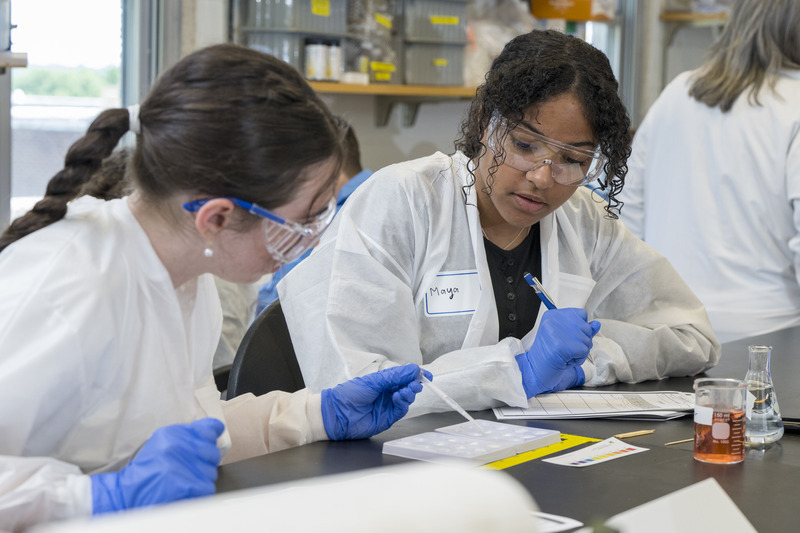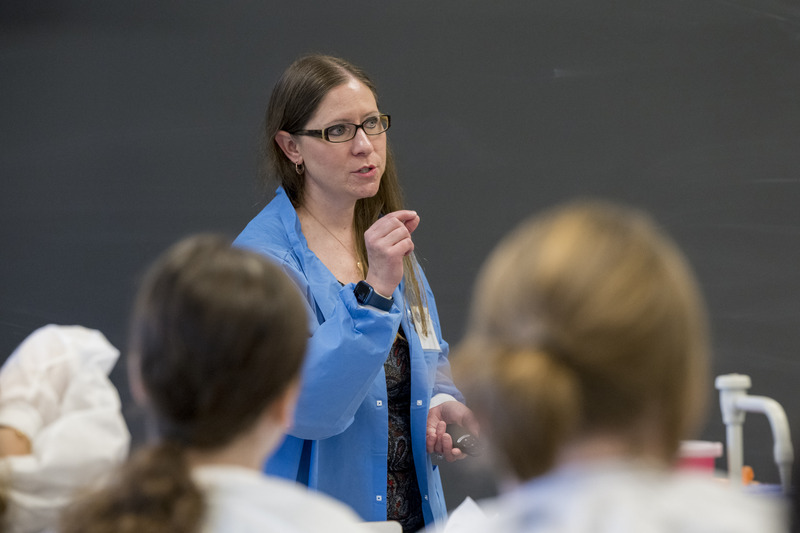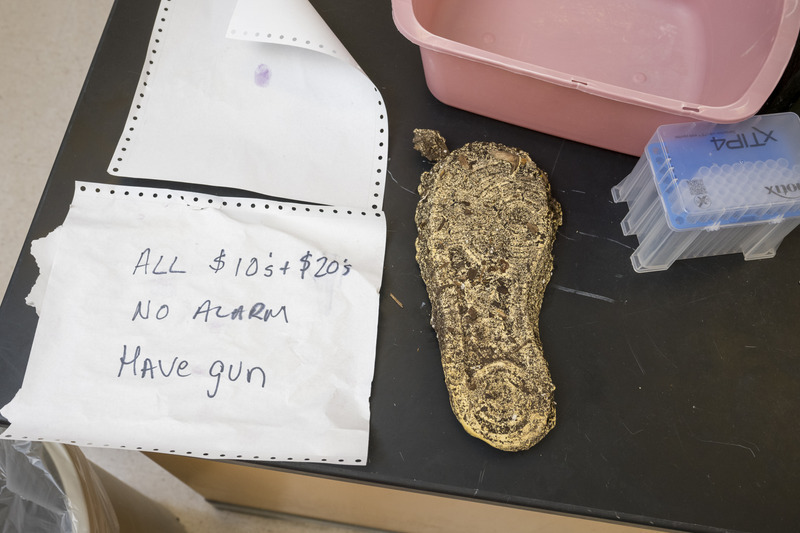
Forensic science program puts the ‘I’ in CSI for 25 crime-solving teens
When she sits down to watch her favorite crime dramas with her dad, 16-year-old Carolyn Reese is right where she likes to be — and can see right where she wants to go: She dreams of working in one of those labs, using science and smarts to turn wisps of evidence into justice and truth.
Thanks to the University of Delaware, she and 24 other budding crime solvers were given an early start on that dream.
The microscopic sleuthing techniques made famous by such TV dramas as CSI and Bones have been nudged into practical reality for Reese and 24 fellow high school students who recently completed the Forensic Science Pre-College Summer Program, jointly offered for the first time this year by UD’s Department of Medical and Molecular Sciences (MMSC) and the Division of Professional and Continuing Studies (UD PCS).
Over the course of a week inside MMSC’s high-tech labs, the students received a crash course in modern methods of fingerprinting, blood typing and other chemistry-driven evidence analysis — all under the guidance of UD faculty and real-world forensic experts. They visited Delaware State Police crime labs, solved their own classroom whodunit using blood and DNA, and even toured the state Division of Forensic Science’s Medical Examiner Unit, a place that few outsiders enter (or leave) voluntarily.
“I’ve always been really interested in science, and I started to watch these shows with my dad,” said Reese, who attends Sussex Academy. “It made me realize this was exactly the part of science I was most interested in and exactly what I wanted to do — going out into the field and collecting the evidence and documenting crime scenes and stuff.”
Your average teen might have been less than enthusiastic about sitting in class during summer break, but these self-professed CSI addicts were inspired from the start. Even before the program began, word of its approach quickly spread on social media and high school networks, fueling a quick sellout.
By the end of the week, the teens would be even more enthralled, but they had also discovered fresh potential: Their TV-enhanced career goals now seem within closer reach, and UD is a great place to make them real. Several said they are recommitting themselves to a career in forensics, and at least one will be heading to UD after graduation, ready to pursue his criminal justice degree.
“I didn’t really know what I was going to do for college,” said Nicholas Riggi, an 18-year-old from Harrington, Delaware, who attended Lake Forest High School. “I always knew that I liked mysteries and stuff. Then, I heard about this program. I wanted to get insight into what it would be like, and I definitely liked what I saw.”
Riggi and his classmates benefitted from access to state-of-the-art techniques and R1 university (very high research activity) lab equipment. For five fast-paced days, they soaked in lectures, conducted lab work and scrambled to finish their capstone projects in time. Some of the students were so excited to attend that they enlisted family members to drive them up to two hours each way every day just to attend.
And yes, there would be a good dose of summertime homework to do as well.
They had barely begun their second day when they were challenged to analyze simulated narcotics samples by the state’s chief forensic toxicologist, Jessica Smith, a UD graduate, instructor in MMSC’s forensic science minor and one-time teenage crime show fan herself. She emphasized the importance of a strict chain of custody and reminded them of the life-altering stakes: True justice frequently depends on a crime lab’s precision and the scientist’s relentless attention to detail.

“If you do not have that attention to detail, you cannot work in this type of facility,” Smith told them as they prepared to test their “narcotics” by carefully portioning samples and mixing them precisely with reagent chemicals. “We have to be good scientists and watch out for cross-contamination,” she reminded them as droplets of reagent fizzed with the samples or changed their color completely.
“I want the right result out the door each and every time,” Smith reminded her students.
Dressed in real-deal lab coats, gloves and safety glasses, the students carefully logged the reactions that might prove (or disprove) a sample’s makeup. Some drugs are well known, Smith reminded them, but others are purposely designed as close chemical analogues, better to evade lab sleuths.
“It’s a new world,” Smith told them, noting that labs must be able to test for more than 30 analogues of fentanyl and also be on the lookout for newly appearing “NPS” drugs — novel psychoactive substances. Even in the grim aftermath of suicide, chemists are finding a whole new class of toxic villains: common allergy medicines that can be fatal in high doses.
Such in-depth and up-to-date knowledge is typically reserved for college students who enroll in UD’s popular forensic science minor, offered by the College of Health Sciences’ Department of Medical and Molecular Sciences. UD also offers a variety of college-level courses designed to prepare students for lab careers. The summer program was designed and led by members of UD’s faculty, including Heather Walters, director of the forensic science minor and an instructor with the Department of Medical and Molecular Sciences. Added support came from Esther Biswas-Fiss, professor and chair of the Department of Medical and Molecular Sciences and an expert in genetics and DNA sequencing.
The rigorous training UD faculty provides is becoming ever more crucial as technology advances, giving law enforcement an arsenal of tools that go far beyond the fingerprint-dusting days of decades past. Today, DNA technology has become swifter and far more certain, and even fingerprinting can be done using just the fumes of superglue. Anthony C. DiNardo, a retired Delaware police officer who oversees the state’s Automated Fingerprint Identification System (AFIS), led the summer program’s section on fingerprint science.
“It’s not just fingerprinting; there’s also technology for face detection, identifying people through their irises,” Smith said. “There’s just so much information out there.”
It’s that kind of growing potential that inspires students like Maya Peoples, a 17-year-old Caravel Academy student who wants to major in forensic psychology.
“I like the ‘solving a mystery’ part of it, figuring it out,” she said. “I’m also intrigued by the psychology behind it because I’m really interested in the way people act, the way their brains work and what causes them to do it.”
Elements of drama and fun were peppered throughout the program’s content, giving students a chance to solve imaginary crime scenarios. In one, a theft of corporate secrets resulted in blood evidence from three suspects, and the students had to use blood typing and DNA analysis to find the true culprit.

“I loved the storyline,” said 17-year-old sleuth Abigail Nalda of Newark, who attends The Charter School of Wilmington. “I thought it was cool to follow it all the way through. We did a whole lab report, so the whole day was correlating together, from start to finish.”
The program attracted students from throughout Delaware and as far away as Frederick, Maryland. One even overnighted in an Airbnb, and others stayed with local friends, to ease the logistics of attending. During the week, the students set up after-class Zoom meetings to fine-tune their group projects, which would be judged on the final day by a panel of experts.
The inaugural class was made up mostly of young women — 17 girls and eight boys — a welcome sign in a time where diversity of the STEM fields is a common goal.
“She’s so excited about this program,” Becky Beale, grandmother of student Madison Beale, 16, who lives in Newark and attends Hodgson Vocational Technical High School. Becky Beale was one of a crowd of relatives and friends who had gathered on the final day to celebrate the young scientists’ “graduation.” “I think she wants to do this as a career path, and this is a great way to get exposure to the field.”
“I’ve always been interested in this stuff,” said Jasmine Garcia, 16, who attends Middletown-Odessa-Townsend Charter School. “I want to make the world a better place. The world is terrible right now.”
UD administrative assistant for noncredit professional programs Rachel Miller, who helped administer the nonresidential program for UD PCS, was on hand daily to help the students in their amazing journey. She also ended up feeling amazed, but mostly by the students themselves.
“We couldn’t have asked for a better first run,” she said of the class. “It was an incredible opportunity to work with such engaged students who were passionate about forensic science. Their thoughtful questions, attention to the lectures and labs, and overall enthusiasm for learning elevated the whole experience.”
On their final day, students received an “official” lab coat, a personalized program reference letter for their resumes and a digital badge to post on their LinkedIn pages.
“Being able to deliver a sold-out program that provided valuable forensic science experiences in a way that kept the joy and excitement of learning was an absolute win for all of us,” Miller said.
UD PCS is working to further expand pre-college program offerings by summer 2025, giving high school students even more opportunities to explore fields of study that are typically reserved for college students.
“The idea behind these pre-college programs is to give participants an opportunity to try out their academic and career interests while still in high school,” said Vic Wang, director of noncredit professional programs for UD PCS. “By spending a week at UD, the students can reaffirm whether the field of study is something they want to do, well before they start their college days or begin their careers.”
More information about future pre-college programs will be made available on the UD PCS website.

